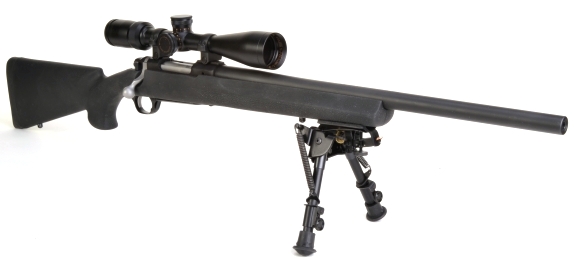
I pulled a trail camera this AM and, upon review of contents, was reminded of what it means to live in a very rural setting. Wild turkeys hogged the lens during daylight hours, several flocks of hens with and an appropriate number of strutting toms. Nighttime brought the deer, twenty different does and a couple of bucks. That deer parade began around 5:30 PM and lasted till sunrise, a pretty wild group. I was half expecting to find a pile of crushed deer brand beer cans in the yard. Maine hunters say there are no deer in the area. I respectfully suggest deer are all over the place, where hunters are not. I’m glad to be old enough to remember that real hunting takes patience, skill and more than a little luck, rather than the newest camo suite, a bottle of Eau de Deer Pee Parfum and an ATV to take the hunter to and from a townhouse of a tree stand or blind. Sorry, sometimes I need to warm up and collect my thoughts before writing…
|
||||||||||||||||||||||||||||
My first reaction to the M77 Tactical, after removing it from the white Ruger box, was… a brief moment of confusion… .308 Winchester? Check. Hand filling tactical stock? Check. Harris Bipod? Check. Bull barrel? Check. Hey, wait a minute! About half a foot of barrel was missing. Head scratch, head scratch… head scratch again.I know my AR brothers cut bull barrels down to very short lengths, but that’s because AR upper and lower receivers weigh over two hundred sixty pounds so, for them, lobbing off a section of heavy bull barrel is a meaningful improvement. Lobbing inches from a bolt action’s barrel? But once I got past my kneejerk reaction and the old gears began turning, amidst all of the squeaking and clanking, came enlightenment. Neato!… That’s Air Force for Oorah!
Why a compact tactical rifle? The short answer…
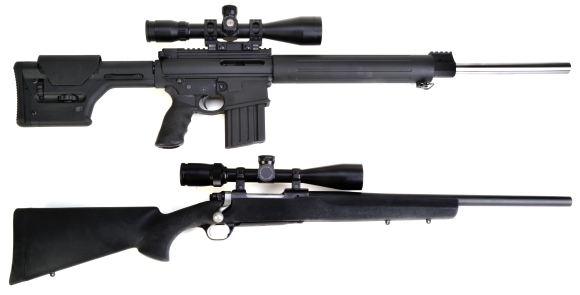
 There is a good deal of anecdotal evidence that suggests, all else equal, a shorter barrel is more accurate. Not exactly breakthrough news as the same was deduced in 1909 when Franklin Mann’s The Bullet’s Flight From Powder to Target was first published. The author dedicated a chapter to multiple, carefully controlled experiments in barrel length, within a test firearm population reflecting multiple calibers and multiple rifle types. The author concluded with his favorite gun’s barrel being progressively reduced from thirty six inches to just over eighteen inches, the gun gaining accuracy with each reduction. How can that be? Glad you asked.
There is a good deal of anecdotal evidence that suggests, all else equal, a shorter barrel is more accurate. Not exactly breakthrough news as the same was deduced in 1909 when Franklin Mann’s The Bullet’s Flight From Powder to Target was first published. The author dedicated a chapter to multiple, carefully controlled experiments in barrel length, within a test firearm population reflecting multiple calibers and multiple rifle types. The author concluded with his favorite gun’s barrel being progressively reduced from thirty six inches to just over eighteen inches, the gun gaining accuracy with each reduction. How can that be? Glad you asked.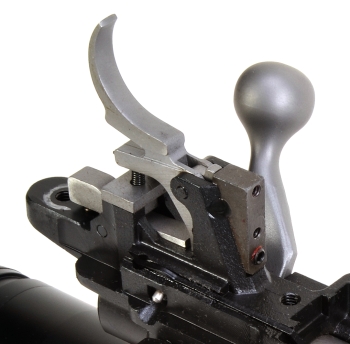 The Ruger Tactical is, in a number of ways, mechanically more closely aligned with Ruger Predator and Target series M77 guns than it is to standard hunting models. The Tactical rifle’s use of a Ruger Target Trigger is an example. It is the adjustable two stage target model, rather than the current non-adjustable, LC6™ trigger utilized with other Ruger models. At 2¼ lb pull as received, the target trigger is slick, crisp and positive in actuation. Personally, I wish this was the trigger used on all M77 rifles. I love two stage triggers… something about getting ready before getting serious and the steadying effect of being able to so deliberately and progressively squeeze a trigger. I don’t like to be surprised into consciousness when a sear releases, I want to be able to precisely determine its release. I could do this with the Ruger Target Trigger.
The Ruger Tactical is, in a number of ways, mechanically more closely aligned with Ruger Predator and Target series M77 guns than it is to standard hunting models. The Tactical rifle’s use of a Ruger Target Trigger is an example. It is the adjustable two stage target model, rather than the current non-adjustable, LC6™ trigger utilized with other Ruger models. At 2¼ lb pull as received, the target trigger is slick, crisp and positive in actuation. Personally, I wish this was the trigger used on all M77 rifles. I love two stage triggers… something about getting ready before getting serious and the steadying effect of being able to so deliberately and progressively squeeze a trigger. I don’t like to be surprised into consciousness when a sear releases, I want to be able to precisely determine its release. I could do this with the Ruger Target Trigger.
Tactical isn’t always a euphemism for “ugly firearm”…
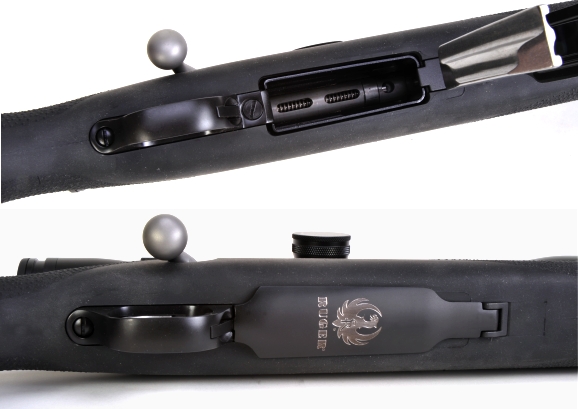
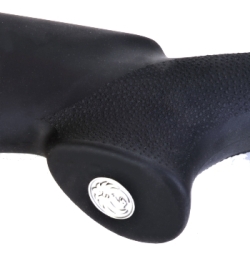
The Ruger is a pretty swoopy rifle. In fact, it’s aesthetic design are so pleasing, I may write the rest of this article in Italian. The bottom metal, inclusive of floorplate and trigger guard, is steel, the Ruger crest is tasteful and appropriate as a signature and the precision cast pieces are cleanly done. Clearly, Pine Tree Castings gives Ruger an edge when it comes to product innovation and quality control.
The floor plate is hinged, the release button is on the front face of the trigger guard and out of the way of unintentional release. It’s operation is positive and lock up is… crisp. The rifle’s bolt is bottom vented as seen in the open floorplate shot. If I wanted to be picky, I might say it would be nice if the trigger guard finish were closer to the matte finish of the floorplate rather than closer to satin. Like I said, picky.
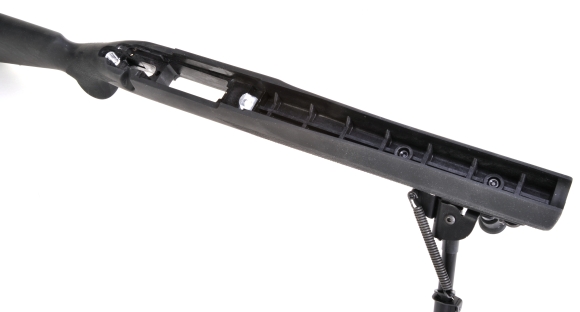
The Hogue OverMolded stock has good lines, a soft feel and excellent proportion for most shooters. The stock is constructed with a rigid fiberglass frame with embedded aluminum pillar blocks, all over molded with resilient synthetic rubber. The result is a soft, anti-slip outside that is also a rigid platform for the barreled action. In the photo above the strengthening ribs and swivel stud bosses are visible as are the three action pillar points. The Hogue stock as two swivel stud in the forearm to permit simultaneous mounting of a bi-pod and sling, but the bi-pod also has a sling attaching point.
Triple Safe and flat bottom metal…
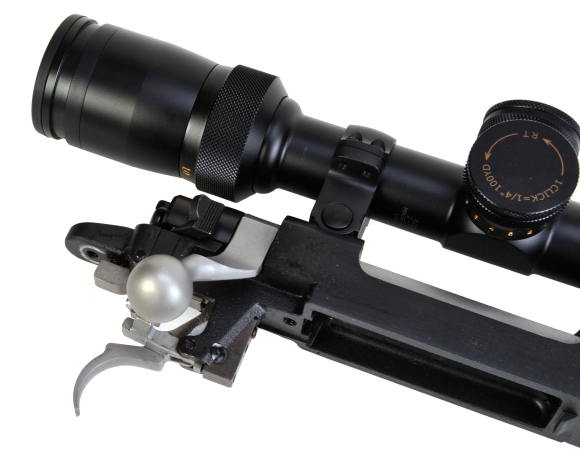
The flat bottom receiver makes for positive, stay put mounting in the Hogue stock. The use of casting as the manufacturing process permits casting trigger mounting bosses integral to the bottom of the action. The Ruger has a stainless steel bolt common to all Ruger bolt action centerfire rifles and a three way safety to allow locked bolt and loading and unloading with the safety engaged.

As is the case with all Ruger rifles, scope mounts are integral to the top of the gun’s receiver. These are notched and keyed to prevent shock induced movement on any axis. A set of 1″ rings are packed in the box, however, rings of different and heights and for 30mm scope tubes are available from Ruger. These can be purchased separately, or swapped free of charge when a new gun is purchased.
Shooting Impressions… Not your typical .308
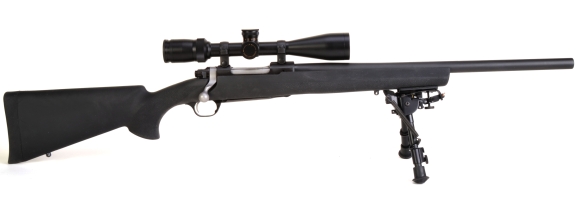

Shooting Hornady Superformance .308 Winchester 150 grain GMX SDF ammo, alongside Federal Fusion and a cross section of handloads with varying components, yielded some pretty exciting results… and “exciting” isn’t an adjective I use very often. As an example, where 150 grain Federal Fusion delivered a very respectable 2746 fps from the Ruger’s 20″ barrel, the Superformance shot a consistent 2869 fps. At 2869 fps, Superformance ammo shot through the Ruger’s 20″ barrel exceed more pedestrian .308 Winchester factory loads by 200 fps and better 150 grain standard factory 30-06 Springfield ammunition ballistics fired through a 24″ barrel.
The rifle is soft recoiling and the bi-pod is useful as well as sturdy. Gimbaled to the mount, it is easy to shoot with the legs on less than level terrain with full support. In this case, that would be shooting prone on the back range, which is like trying to get a steady rest on a pile of rocks. Three shot groups we very tight, as small as half inch and maybe a little better at 100 yards and the trigger feel was perfect. I guess it would be easiest to express as this is a gun that can be shot with a good deal of confidence and it is easy to pick up and shoot well with very little familiarization.
I am looking forward to some 200 yard range time and some additional ammunition to arrive. I will publish complete factory and handload results for the Ruger Tactical at that time.

Email Notification